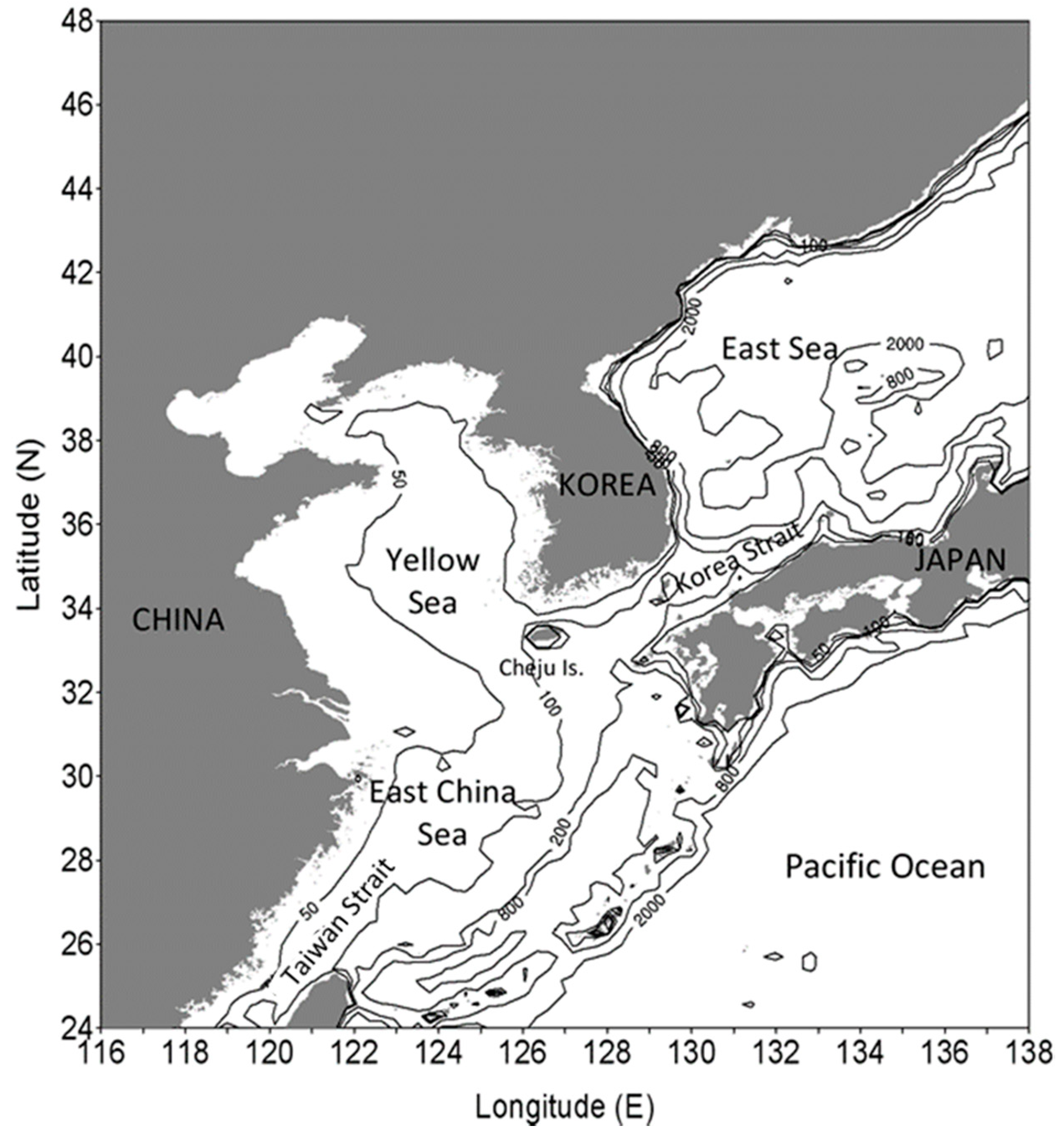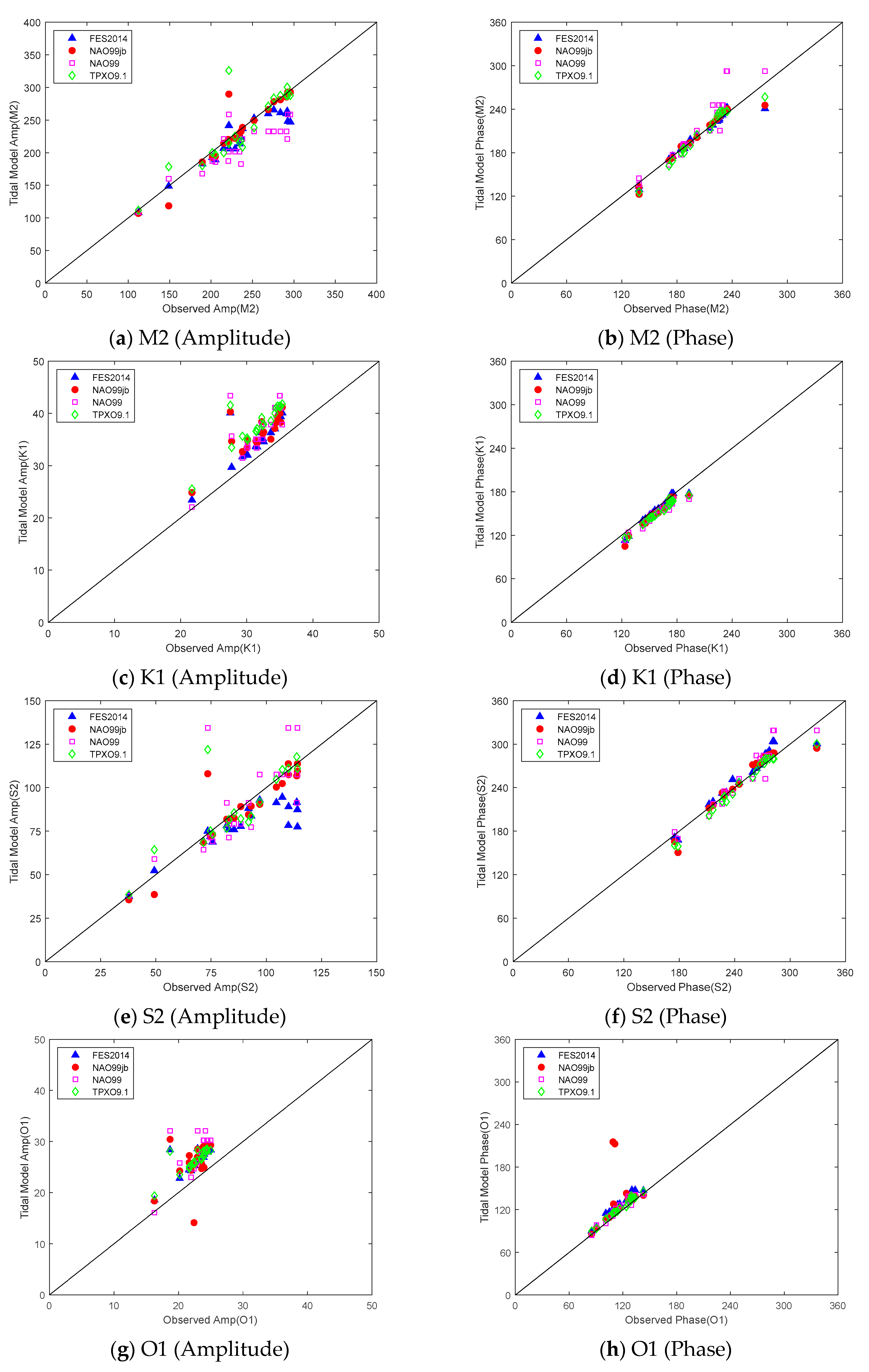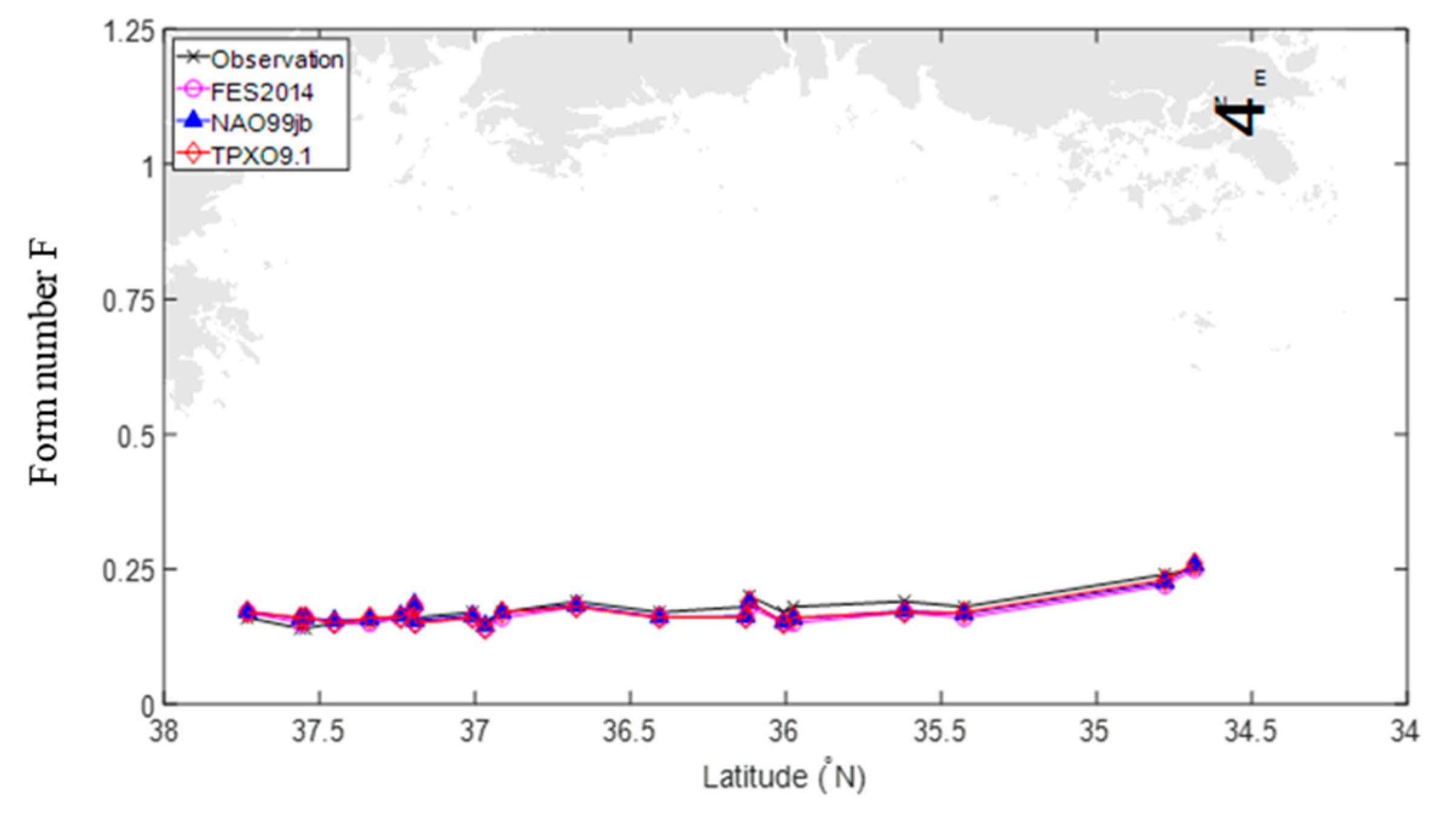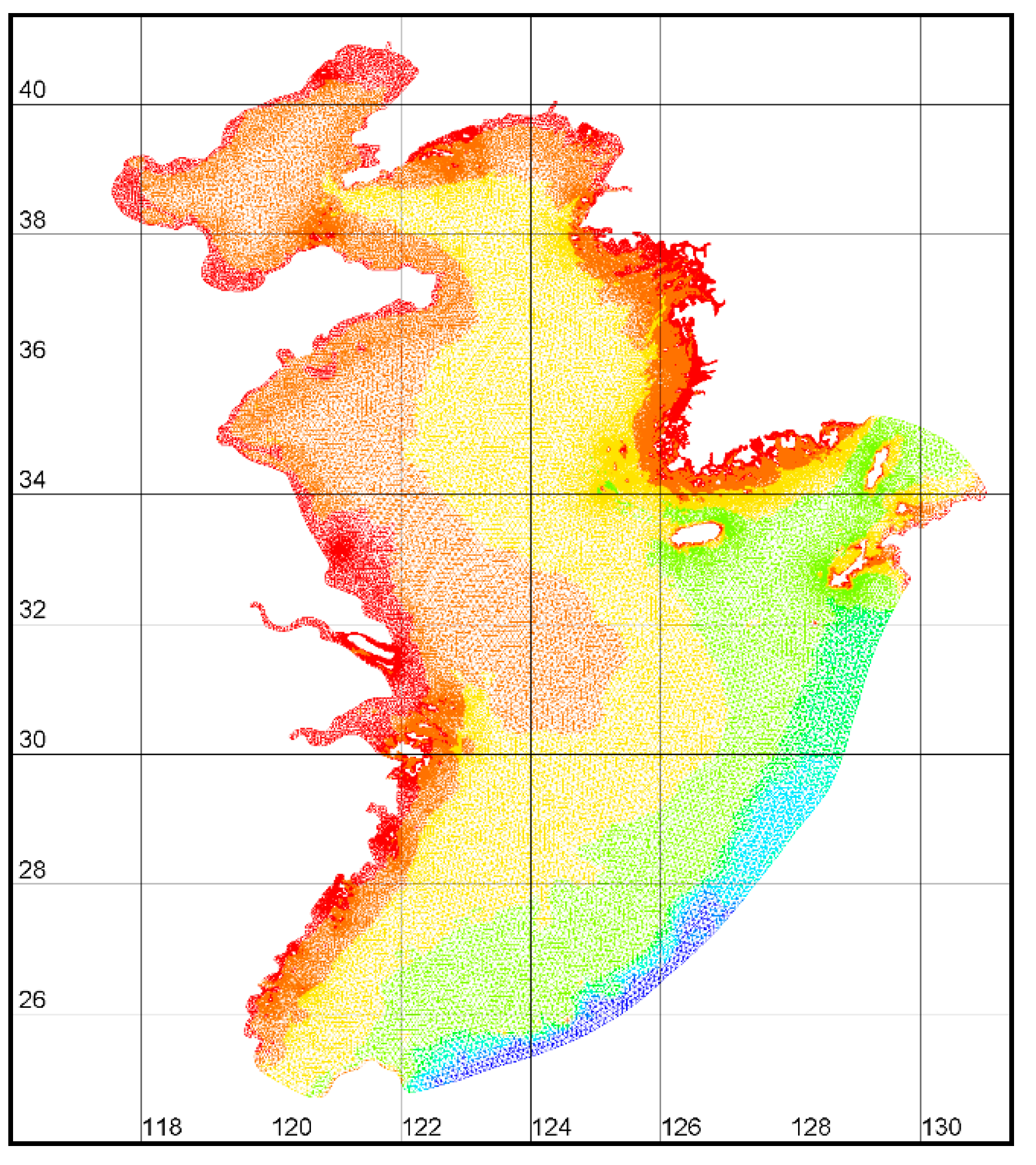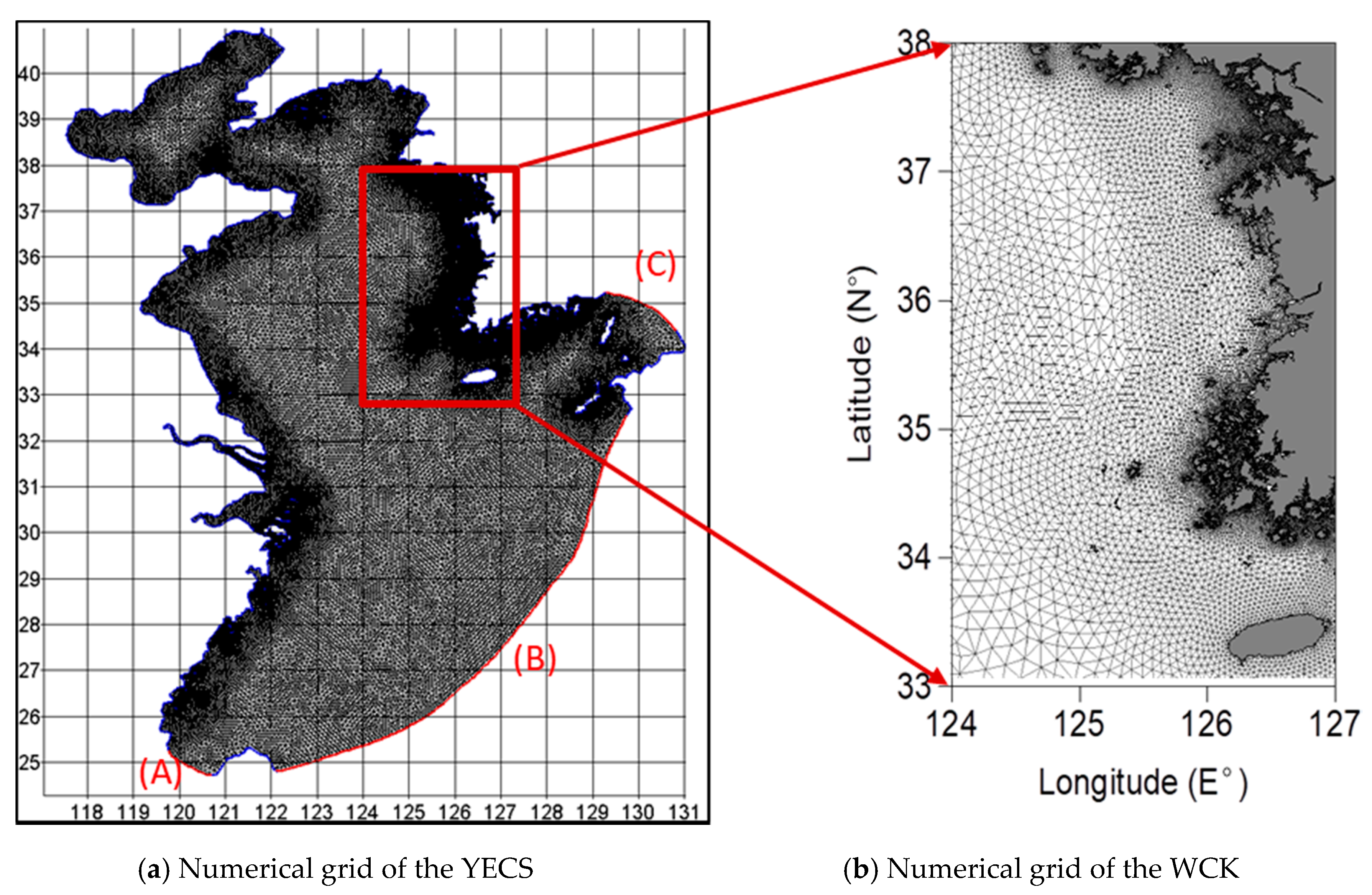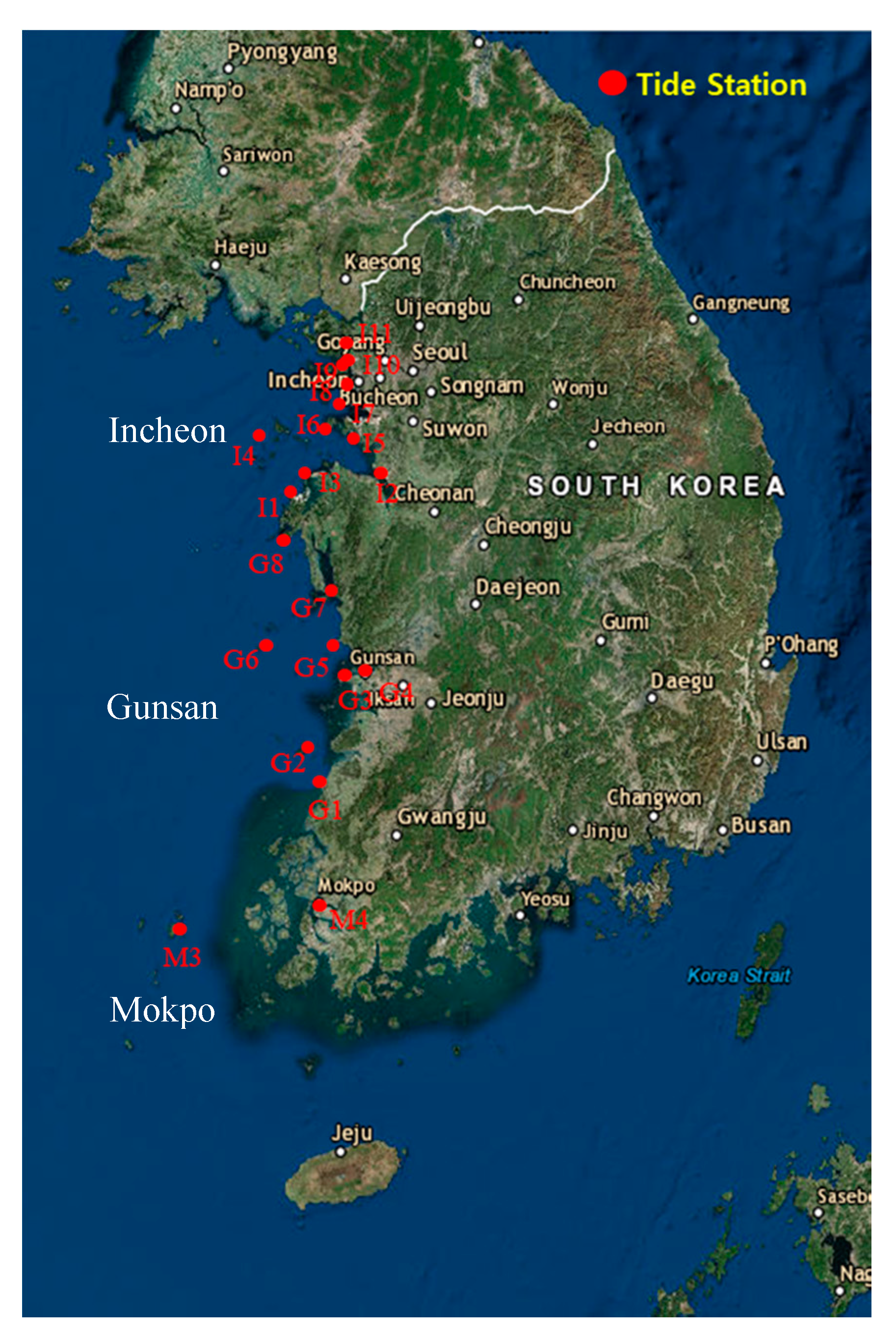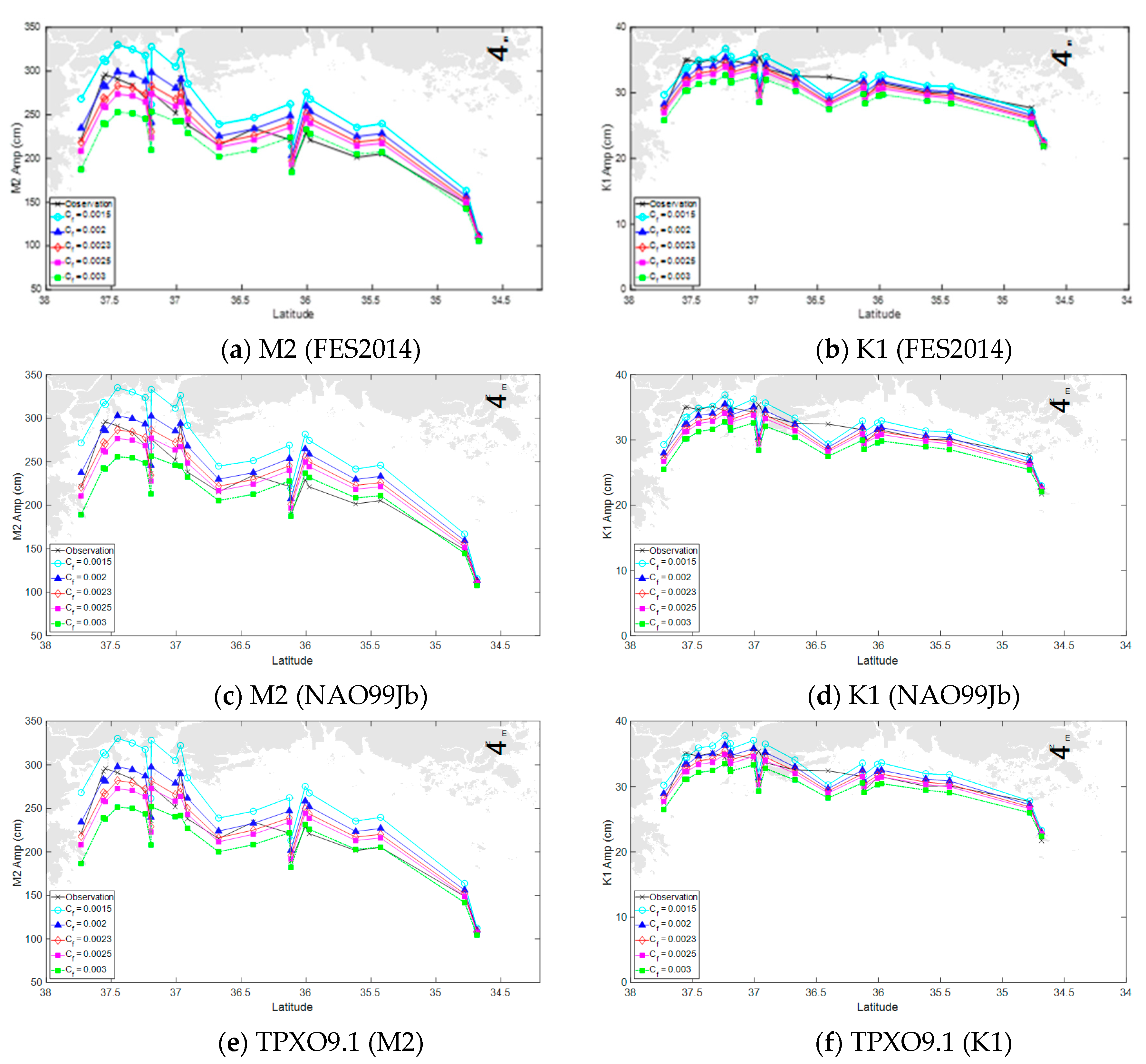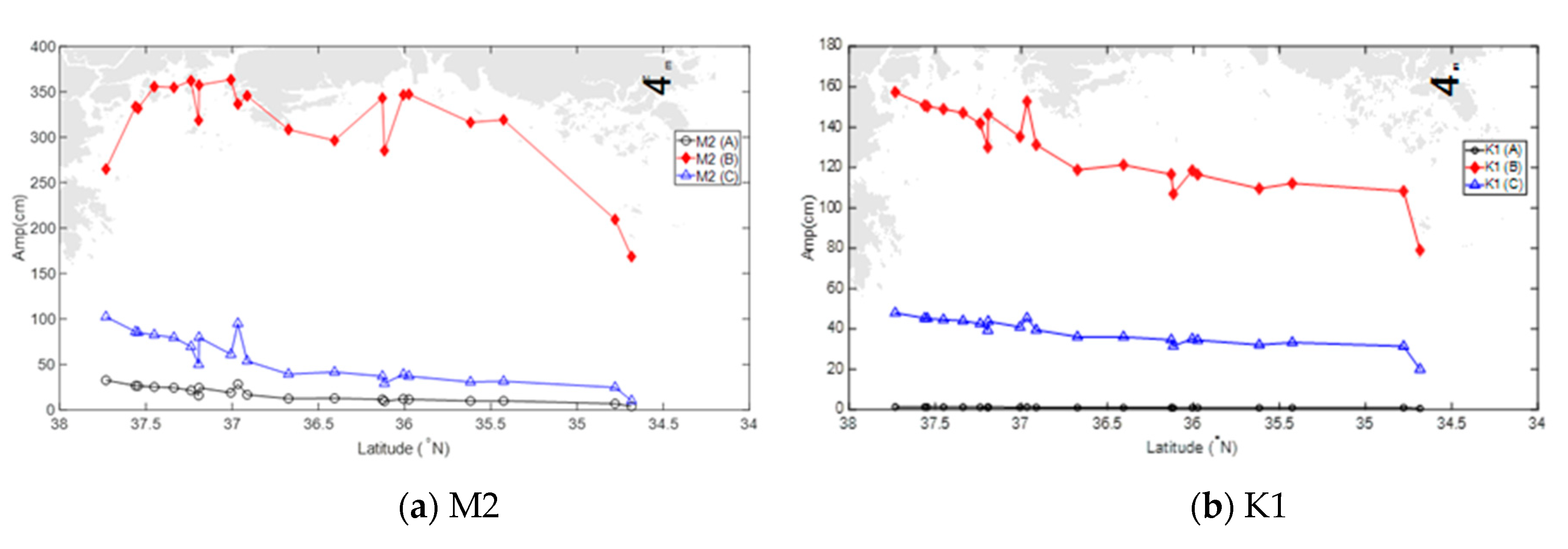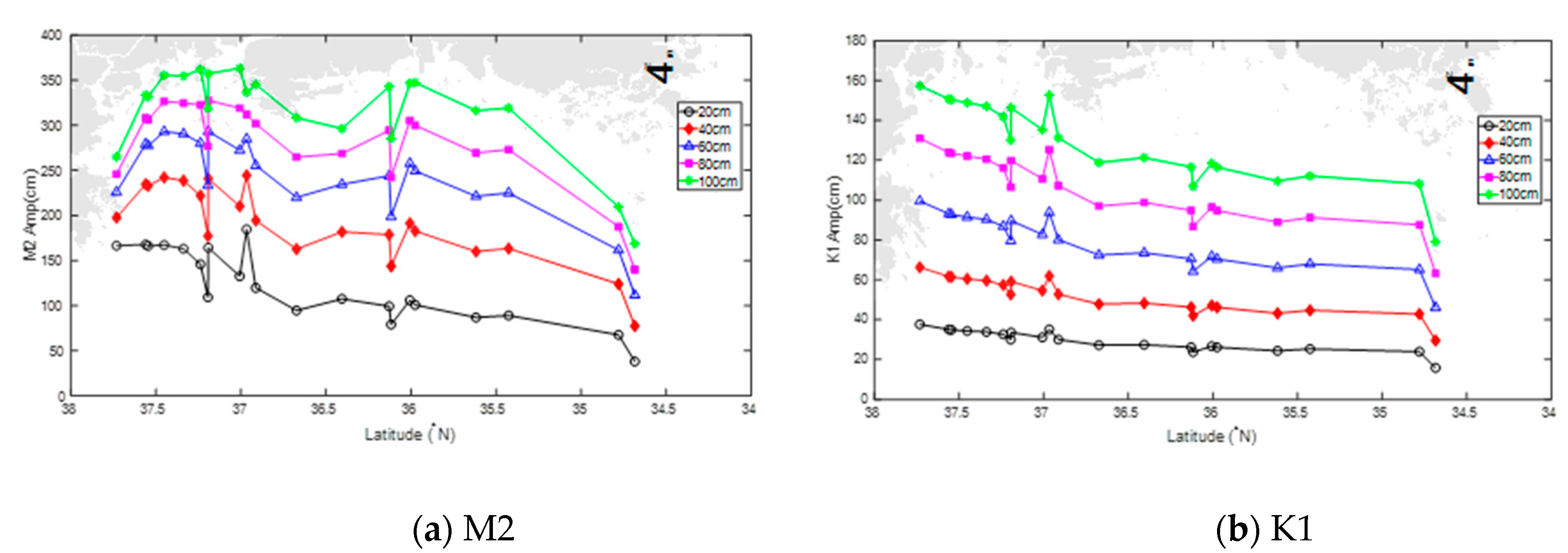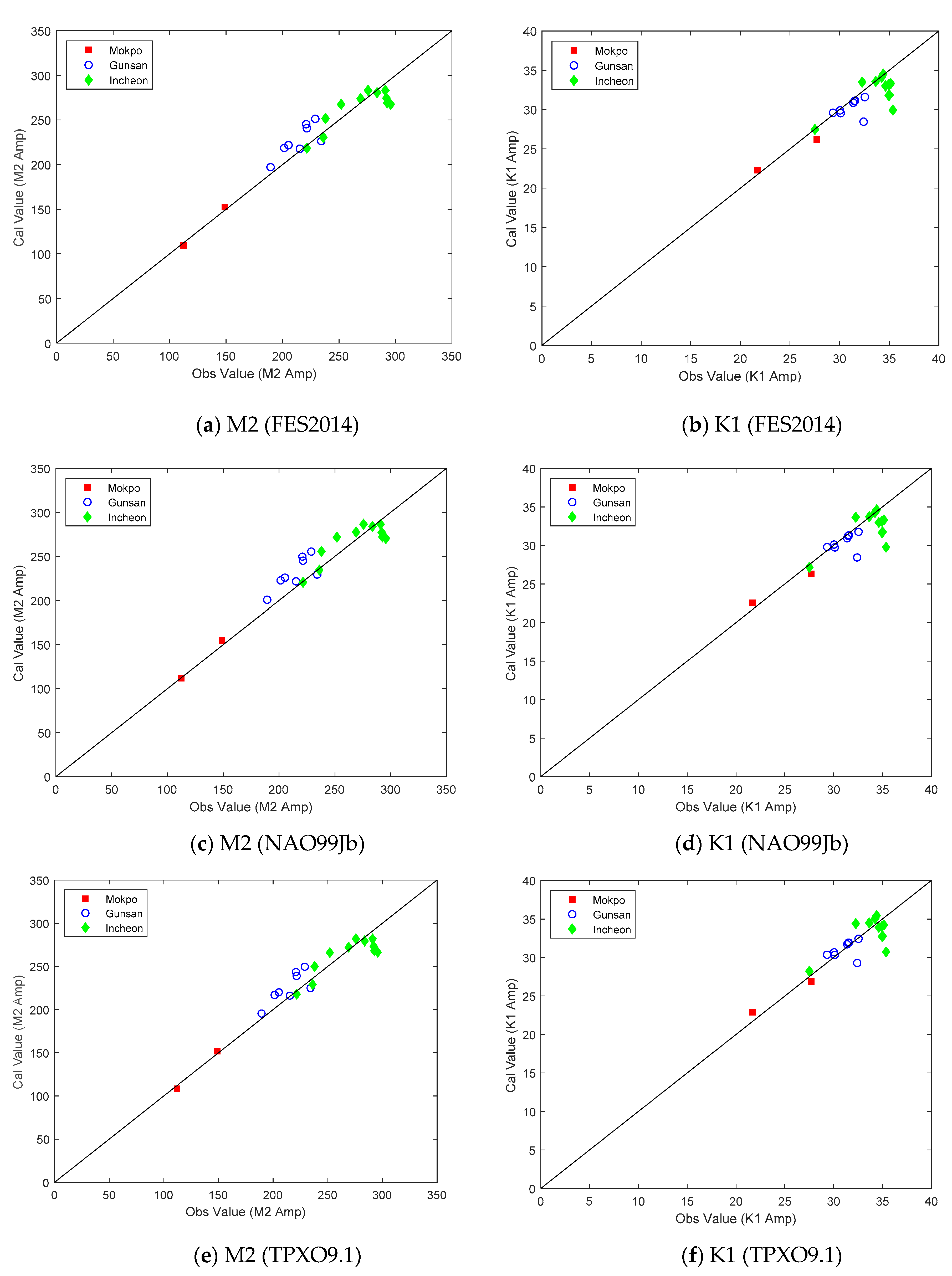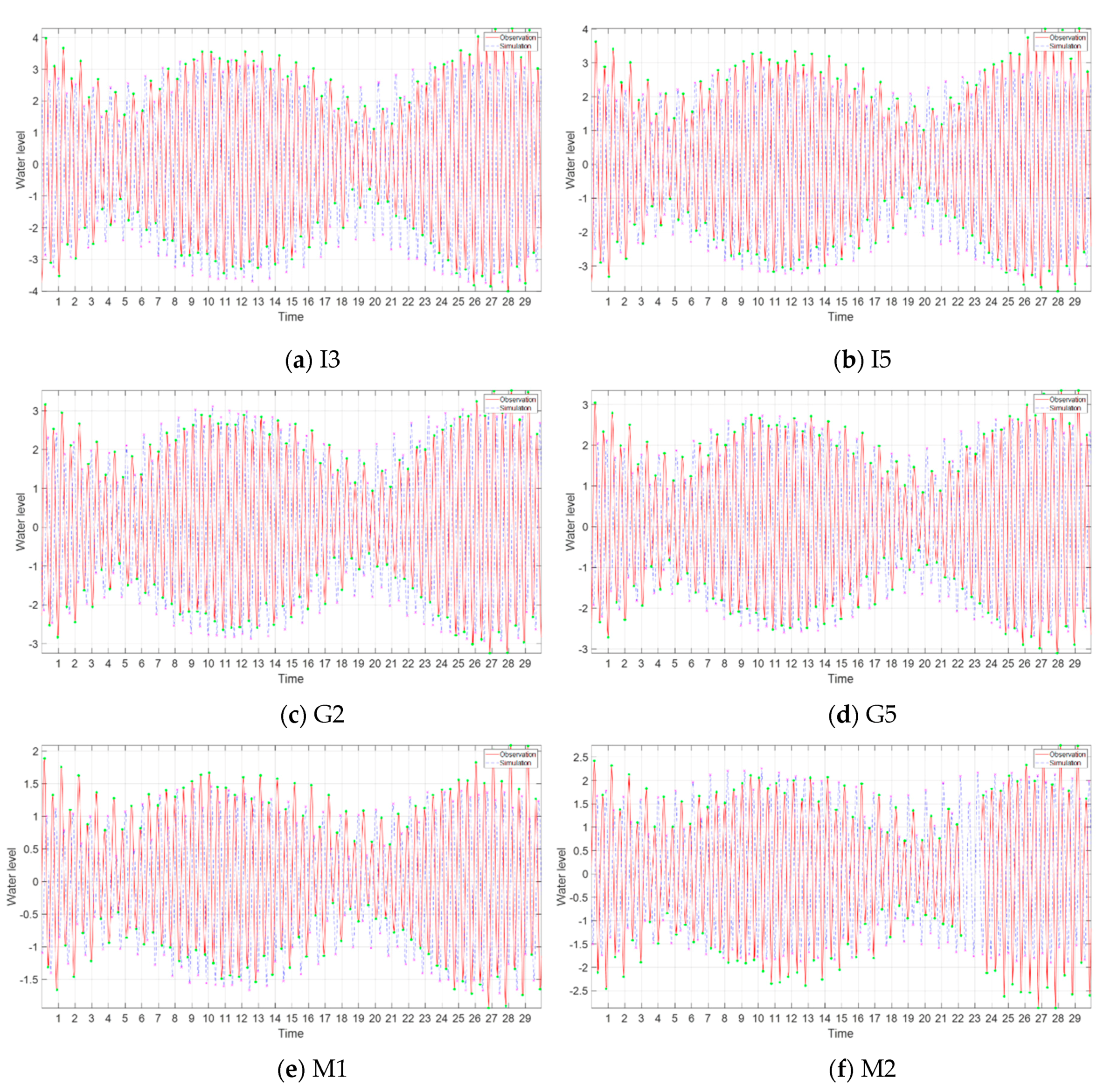1. Introduction
The Yellow Sea (YS) is located between the mainland of China and the Korean Peninsula, and its depth is about 44 m on average, with a maximum depth of 152 m. The sea bottom slope gradually rises toward the East China coast and more abruptly toward the Korean Peninsula, and the depth gradually increases from north to south. Southern YS is bounded by the East China Sea (ECS) along a line running northeastward from the mouth of the Changjiang River to the southwestern tip of Korea. ECS covers the area originating around the Taiwan Strait at about 25° N, extending northeastward to the Kyushu Island, Japan, and to the Korea Strait, and bounded by the Ryukyu Island chains on the southeastern open ocean (
Figure 1). On the broad and shallow shelf under the Yellow and the East China Sea (YECS), the flow is dominated by strong semidiurnal M2 tidal currents with the superimposition of semidiurnal S2, diurnal K1 and O1 currents [
1,
2,
3,
4]. Approaching the WCK, the tidal amplitudes vary from 4 to 8 m, and the speed of the tidal current may increase to more than 1.56 m/s near the coasts.
Along with strong tidal currents, the WCK is surrounded by lots of islands including extremely irregular and indented coastlines, the tidal propagation and shoaling processes on the shore in this broad flat region are very complicated and sensitive to the variation of tidal elevation.
The study on the tidal circulation in this region has been carried out by various authors, such as Le Fevre et al. [
5], Kim [
6], Naimie et al. [
7], and Suh [
8] using 2D depth-averaged finite element models on unstructured grids, or Choi [
2], Tang [
9], Kantha et al. [
10], Kang et al. [
11] and Lee et al. [
12] using 3-D finite difference models on structured grids. However, there are still very few authors using data obtained from different assimilated tidal models to set up the offshore boundary conditions. Most authors have applied a constant boundary forcing condition (BFC) or tidal charts, such as Ogura’s chart [
1,
2,
13,
14]) and Nishida’s chart [
3,
15,
16] or applied a very coarse observation data combined with partly constant boundary forcing conditions [
11,
17]. Only Le Fevre et al. [
5] and Suh [
8] have applied tidal charts from FES 94.1 and FES 2004 models for OBC. Using FVCOM, we recently applied a tidal chart from NAO.99Jb. In principle, the tidal information around the WCK can be obtained from assimilated global and regional tidal models [
18].
In principle, the tidal information around the WCK can be obtained from assimilated global and regional tidal models. The assimilation model, which is a combination of a dynamical model and observed data, was actively advanced in the research group of the modern global tide model, and pioneered by [
19]. By the assimilation model, the problem of the empirical method with regard to the resolution can be compensated by a hydrodynamic model, and any inadequate potential of the hydrodynamic model can be recovered by observed data [
20]. Recently, using the unprecedented sea surface height data of satellite altimeter TOPEX/POSEIDON (T/P), several research groups have developed highly accurate assimilation models especially in an open ocean ([
5,
20,
21,
22,
23,
24]). T/P was launched on 10 August 1992, which measures sea level relative to the ellipsoid with an overall accuracy of approximately 5 cm [
25]. Due to the high accuracy of T/P altimeter data for those assimilation models, it can be used to extract relatively accurate tidal boundary conditions around the marginal sea within YECS.
Among the global assimilation models, FES2014 (
https://www.aviso.altimetry.fr/en/data/products/auxiliary-products/global-tide-fes.html) and TPXO9.1 (
http://volkov.oce.orst.edu/tides/tpxo9_atlas.html) atlases are open to the public and can be freely downloaded. The FES2014 atlas was produced by Legos and CLS Space Oceanography Division, and distributed by Aviso, with support from CNES (
https://datastore.cls.fr/catalogues/fes2014-tide-model/). It is distributed as a tidal chart on grid resolution of 1/16° based on the dynamical finite element tide model CEFMO, and data assimilation code CADOR. The finite element grid of the model CEFMO has about 2,900,000 computational nodes and covered 34 tidal constituents. In addition to above two global tide models, the regional tide model NAO.99Jb (
https://www.miz.nao.ac.jp/staffs/nao99/index_En.html) was developed by Matsumoto et al. (2000) for the region around Japan with a resolution of 1/12°, covering from 110 to 165° E and from 20–65° N so that YECS was entirely included in this region. This model was nested with the global model NAO.99b to provide open boundary conditions to the regional model and the assimilation was performed with both T/P data and 219 coastal tidal gauges obtained around Japan and Korea. Most T/P-derived altimetric tides can be inaccurate in shallow coastal oceans because the resolution enforced on data analysis by the spatial resolution of T/P is simply inadequate near ocean margins.
Therefore, we first validated the tidal information of tidal constituents
provided by three assimilated tidal models; FES2014, NAO99Jb and TPXO9.1 against the observation at 21 tidal gauges along WCK.
Figure 2 shows the comparison of amplitude (left) and phase (right) obtained from the assimilated tidal models with observation data obtained from gauging stations along the WCK. It shows that while the phases are better agreement with observation, the amplitudes obtained from the assimilated tidal models still poorly agreed with the observed data. More detailed quantitative comparisons between the amplitude and phase obtained from the assimilated tidal models and observation data are shown in
Table A1 (in
Appendix A). Wherein it shows NAO99Jb provides a better agreement of the amplitude for the constituents
, while FES2014 provides a little better fit of the amplitude for
. It also shows the constituent M2 has the largest amplitude in comparison with other tidal constituents; about 5–8 times, 2.5–2.8 times, and 6.6–11.8 times larger than K1, S2 and O1 amplitudes, respectively.
In addition, the resolutions (1/6°, 1/12° and 1/16°) of three tidal models are not fine enough along the coastlines, so they cannot provide enough detailed quantitative and qualitative tidal information along the WCK. Therefore, in order to obtain more detail on tidal information along the WCK, an accuracy numerical simulation with higher grid resolutions is needed.
This study is to introduce several numerical investigations using higher grid resolutions and applying different open boundary conditions extracted from three well-known assimilated tidal models FES2014, TPXO9.1 and NAO.99Jb then calibrated with different uniform and non-uniform bottom roughness values for different sub-regions within WCK to investigate the effect of open boundary condition and bottom roughness on the tidal elevations from major constituents (M2, K1, S2 and O1) around the West Coast of Korea.
Based on the form number (
F), the ratio of the amplitudes of
suggested by [
26] is shown in Equation (1).
whereby the mixed tide is classified following the value of the form number
F; if the value of
F less than 0.25 or larger than 1.25, then it is classified as semidiurnal or diurnal, respectively. Otherwise, if the value of
F is located between 0.25 and 1.25, it is considered mixed.
Figure 3 shows the values of the form number along the WCK are below 0.25 according to the data obtained from observation at 21 tidal gauges, as well as from three assimilated tidal models, FES2014, TPXO9.1 and NAO.99Jb; therefore, the mixed tide prevails semidiurnal in the WCK.
2. Numerical Modeling
As mentioned above, since the study region was quite shallow, the numerical simulation was based on an open-source software, the TELEMAC-2D (
http://www.opentelemac.org) model. It is well-known software with an abundant history of development and application over many years in fluvial and maritime hydraulics [
27,
28]. The TELEMAC-2D is capable of capturing the complicated bathymetry and coastlines of the WCK surrounded by lots of islands including extremely irregular and indented coastlines by using unstructured grids.
2.1. Basic Equations
The TELEMAC-2D has solved the depth-averaged Navier-Stokes equations with two-equation turbulence closure models (k-ε) using the finite element method, as follows:
The continuity equation
and momentum equations
where
h is the water depth;
U and
V are the depth averaged velocity components;
and
Z and Zf are the free surface and bottom elevations, respectively;
Fx and Fy are body forces in x and y directions including Coriolis (, bottom friction , and surface wind forces determined as and
Coriolis force; and ; is angular and is latitude;
Bottom friction force; and , where Cf is the bottom friction coefficient, , n is Manning’s coefficient;
Wind forcing on the free surface is neglected; i.e., () = 0.
And
is the effective viscosity, the summation of the molecular viscosity
ν and the turbulent viscosity
νt ; where
The depth averaged kinetic energy
k and its dissipation rate
ε are:
where
is the fluctuating velocity and the overbar represents an average over time; i.e.,
;
Ui (=
U or
V) is an average over time of velocity components; and
P is the production term:
Pkv and Pεv are vertical shear terms: where and
is the friction velocity:
The empirical constants in Equations (5) and (6) of the k-ε model are obtained from classical test cases.
2.2. Boundary Conditions
2.2.1. At the Solid Boundary
On the solid boundary, such as coastline and bottom, the no-slip condition is applied; i.e., velocity .
In this region, particularly near the shallow coastline, the effect of bottom friction becomes prominent, the bottom friction is calculated by:
The value of the coefficient
Cf is obtained from the calibration procedure, which is shown in
Section 3.1 below.
The boundary condition for turbulence kinetic energy and its dissipation are defined as
where
δ is a distance from the wall,
of a local mesh size;
is friction velocity of the wall.
2.2.2. At the Free Surface
We assume the wind force on the free surface is neglected as mentioned above, i.e., .
2.2.3. At the Open Boundary
Tidal harmonic parameters obtained from each assimilated tidal models FES2014, NAO99Jb and TPXO9.1 were combined into the open boundary conditions, as follows:
where
Hi is the water elevation,
is amplitude;
T is period and
is phase of each tidal constituent.
In this study, four major tidal constituents M2, K1, S2 and O1, were considered. The harmonic constants of tidal constituents for open boundary conditions were obtained from three assimilated tidal models; FES2014, TPXO9.1 and NAO.99Jb.
Turbulence kinetic energy and its dissipation at the open boundary were set as:
and .
2.3. Study Region
The study area covered the entire YS and most of the ECS in spherical coordinate. The bathymetry data of 30 arc-seconds resolution was downloaded from the General Bathymetric Chart of the Ocean (GEBCO2014:
https://www.ngdc.noaa.gov/mgg/ibcm/ibcmdvc.html) as shown in
Figure 4. The shorelines with an accuracy of about 250 m were downloaded from the NOAA shoreline website (
https://shoreline.noaa.gov). This region included the flat and broad continental shelf of YECS, bounded by Taiwan Strait (A), a line of shelf-break determined by 200 m isobaths (B), and Korea Strait (C), as shown in
Figure 5. The open boundary was expanded to the shelf edge of YECS which was advantageous to use offshore co-oscillating tidal conditions as a boundary forcing in order to minimize disturbances by the geographical configuration and nonlinear tidal response near-shore. Open boundaries adjacent to the offshore also enabled the numerical results around WCK to minimize the influence of unexpected numerical instabilities at open boundaries.
In this study, the numerical simulation applied a hybrid horizontal resolution of an unstructured grid using a free pre-processing Blue Kenue software tool (
https://nrc.canada.ca/en/research-development/products-services/software-applications/blue-kenuetm-software-tool-hydraulic-modellers). Herein the unstructured triangular grid had a horizontal resolution varying from 0.2 to 1 km in the WCK, 3–5 km in the East coast of China, and 9–12 km in the interior of YS and ECS. After running a number of simulations to check for grid independence, the final grid of 203,927 grid cells was used for the simulation in this study. Bathymetry was interpolated to each nodal point of the horizontal grid using Blue Kenue software as well (
Figure 5).
A total of 21 tidal gauges were collected around the WCK to provide the observed tidal elevation data of semidiurnal M2 and S2 and diurnal K1 and O1 constituents in YECS. As shown in
Figure 6, the WCK can be divided into three sub-regions based on the common characteristics of their bathymetry and coastlines—the first region was Kyunggi Bay near Incheon (I), the second region was around the estuary of the Geum River near Gunsan (G), and the third region was around the south-western tip near Mokpo (M). The numbers of tidal gauges located in three regions Mokpo, Gunsan and Incheon were 2, 8 and 11, respectively. The most recent observation data in 2017 downloaded from Korea Hydrographic and Oceanographic Agency (
http://www.khoa.go.kr/koofs/kor/observation/obs_real.do) have been selected for the calibration and validation of numerical models.
4. Conclusions
The main goal of this study was to use various numerical investigations to figure out the response of coastal tides in the WCK to the open boundary conditions and bottom roughness. After the application of three different open boundary conditions interpolated from three different assimilated tidal models (FES2014, NAO.99Jb and TPXO9.1), it has been shown that there were no significant differences between the responses of tidal amplitudes in the WCK induced by three open boundary conditions obtained from three assimilated tidal models. In addition, the numerical simulation of the tidal flow in the WCK should not use a uniform bottom roughness coefficient. Due to the complicated bathymetry, indented coastlines and bed variability of the WCK, it caused strong local effects on the tides in this region. Therefore, a non-uniform bottom roughness should be applied to the modeling whereby the smallest value can be applied for Incheon, a larger value for Mokpo, and the largest value for Gunsan. The largest value of the bottom roughness coefficient was applied to the Gunsan region because its bed form was more variable than other regions. The numerical results show that the accuracy of the modeling of the tidal elevation around the WCK was strongly dependent on the bottom roughness rather than the offshore tidal boundary conditions. Moreover, the numerical results can provide not only a better fit to the observations but also higher spatial resolutions in comparison to the results obtained from assimilated tidal models around the WCK.
However, it should be noted that the numerical results obtained from this study were still limited due to the coarse resolution (30 arcs/second) of bathymetry obtained from GEBCO2014, which was not sufficient to capture the real geometries, whose sizes were less than such resolution. Therefore, a further study with a higher resolution is necessary in order to obtain a more precise prediction of the tidal current and its elevation around the WCK. Furthermore, the wind forcing on the sea surface and the tidal energy dissipation should be taken into account.
